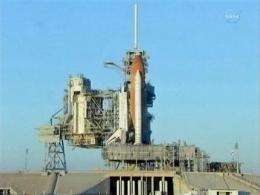NASA fuels shuttle Discovery in test for cracks

(AP) -- NASA fueled space shuttle Discovery at the launch pad Friday, not for flight but rather for testing to understand the mysterious cracking that occurred last month.
Discovery is grounded until at least the beginning of February because of potentially dangerous cracks that popped up in the fuel tank during an actual launch attempt. The cracks have been fixed, but engineers still do not understand why they occurred.
So in a countdown test that began shortly after sunrise, the launch team pumped more than 500,000 gallons of liquid hydrogen and oxygen into Discovery's external fuel tank. The tank was rigged with nearly 100 strain gauges and temperature sensors to provide clues to the cracking, and thousands of feet of wiring for recording devices.
Whenever Discovery does fly, it will be its last trip into orbit and one of the final two or three shuttle missions remaining. It's loaded with supplies for the International Space Station as well as an experimental humanoid robot.
"We're not committing to flying anytime soon. We've got to wait until we know we have a good answer to go fly," Mike Moses, a launch manager, said as Discovery's 15-story tank filled up. "We want to make sure we know the risk we have in front of us."
Back on Nov. 5, NASA halted the countdown for Discovery because of leaking hydrogen gas. An unrelated problem - cracking - later was discovered in the insulating foam of the fuel tank, in the ribbed central portion that holds instruments. When the foam was removed, cracks were found in two of the more than 100 aluminum ribs, or brackets, making up that area. The two damaged ribs - 21 feet long apiece - were next to each other.
Both the leak and cracks were fixed, and NASA aimed for a possible December flight. But engineers were stumped as to what caused the cracks. They now believe there may have been a buildup of stress in the brackets during assembly, which caused them to crack when the super-cold fuel was loaded into the tank, Moses said.
"We are 100 times smarter than we were a week ago, and we're 1,000 times smarter than we were when the failure first happened," Moses said. "We're not probably going to come out of here with a smoking gun. But we're going to come out of here with a family of failures."
The concern is that any cracks in the brackets could cause chunks of foam to pop off and, in the worst case, slam into the Discovery at liftoff. A large slab of foam damaged Columbia during launch in 2003 and led to its destruction during re-entry.
Besides stringing cables with gauges and sensors on the suspect portion of the tank, technicians also painted small black dots - 10,000 to 12,000 of them - on the exposed white foam over the repaired area. Moses called it finger-painting and it was; the technicians worked in freezing temperatures, dipping their gloved fingers in paint and then pressing them gently onto the foam. Twice as many dots were painted on another section at the back of the tank.
The dots were part of an optics test. A pair of cameras were aimed at them for stereoscopic views. The intent was to record the motions of the tank in that area and provide additional clues to the cracking.
Altogether, NASA expects to gather 6 terabytes of data from Friday's test. The information will be analyzed over the coming week.
Discovery, meanwhile, will be returned to the Vehicle Assembly Building next week so engineers can X-ray the brackets on the back of the fuel tank. These areas are inaccessible at the launch pad.
The goal is to launch Discovery as early as Feb. 3 or at least by month's end, Moses said.
NASA's shuttle program is set to retire next year after 30 years of flight. Space shuttle Endeavour is due to fly in April, and Atlantis may follow in the summer if funding is forthcoming.
More information: NASA: http://www.nasa.gov/mission-pages/shuttle/main/index.html
©2010 The Associated Press. All rights reserved. This material may not be published, broadcast, rewritten or redistributed.




















